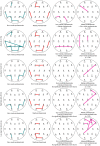The Effect of Media Professionalization on Cognitive Neurodynamics During Audiovisual Cuts
- PMID: 33584210
- PMCID: PMC7876408
- DOI: 10.3389/fnsys.2021.598383
The Effect of Media Professionalization on Cognitive Neurodynamics During Audiovisual Cuts
Abstract
Experts apply their experience to the proper development of their routine activities. Their acquired expertise or professionalization is expected to help in the development of those recurring tasks. Media professionals spend their daily work watching narrative contents on screens, so learning how they manage visual perception of those contents could be of interest in an increasingly audiovisual society. Media works require not only the understanding of the storytelling, but also the decoding of the formal rules and presentations. We recorded electroencephalographic (EEG) signals from 36 participants (18 media professionals and 18 non-media professionals) while they were watching audiovisual contents, and compared their eyeblink rate and their brain activity and connectivity. We found that media professionals decreased their blink rate after the cuts, suggesting that they can better manage the loss of visual information that blinks entail by sparing them when new visual information is being presented. Cuts triggered similar activation of basic brain processing in the visual cortex of the two groups, but different processing in medial and frontal cortical areas, where media professionals showed a lower activity. Effective brain connectivity occurred in a more organized way in media professionals-possibly due to a better communication between cortical areas that are coordinated for decoding new visual content after cuts.
Keywords: connectivity; expertise; film cuts; neurocinematics; professionalization; visual perception.
Copyright © 2021 Andreu-Sánchez, Martín-Pascual, Gruart and Delgado-García.
Conflict of interest statement
The authors declare that the research was conducted in the absence of any commercial or financial relationships that could be construed as a potential conflict of interest. The reviewer GC declared a past co-authorship with two of the authors AG and JMD-G to the handling editor.
Figures





Similar articles
-
Beta-band differences in primary motor cortex between media and non-media professionals when watching motor actions in movies.Front Neurosci. 2023 Jun 26;17:1204809. doi: 10.3389/fnins.2023.1204809. eCollection 2023. Front Neurosci. 2023. PMID: 37434763 Free PMC article.
-
Chaotic and Fast Audiovisuals Increase Attentional Scope but Decrease Conscious Processing.Neuroscience. 2018 Dec 1;394:83-97. doi: 10.1016/j.neuroscience.2018.10.025. Epub 2018 Oct 24. Neuroscience. 2018. PMID: 30367947
-
Looking at reality versus watching screens: Media professionalization effects on the spontaneous eyeblink rate.PLoS One. 2017 May 3;12(5):e0176030. doi: 10.1371/journal.pone.0176030. eCollection 2017. PLoS One. 2017. PMID: 28467449 Free PMC article.
-
Eyeblink rate watching classical Hollywood and post-classical MTV editing styles, in media and non-media professionals.Sci Rep. 2017 Feb 21;7:43267. doi: 10.1038/srep43267. Sci Rep. 2017. PMID: 28220882 Free PMC article.
-
The brain basis of audiovisual affective processing: Evidence from a coordinate-based activation likelihood estimation meta-analysis.Cortex. 2019 Nov;120:66-77. doi: 10.1016/j.cortex.2019.05.016. Epub 2019 Jun 8. Cortex. 2019. PMID: 31255920 Review.
Cited by
-
Viewers Change Eye-Blink Rate by Predicting Narrative Content.Brain Sci. 2021 Mar 26;11(4):422. doi: 10.3390/brainsci11040422. Brain Sci. 2021. PMID: 33810422 Free PMC article.
-
Interpretation of AI-Generated vs. Human-Made Images.J Imaging. 2025 Jul 7;11(7):227. doi: 10.3390/jimaging11070227. J Imaging. 2025. PMID: 40710614 Free PMC article.
-
The role of individual differences in resistance to persuasion on memory for political advertisements.Front Psychol. 2023 Aug 9;14:1196209. doi: 10.3389/fpsyg.2023.1196209. eCollection 2023. Front Psychol. 2023. PMID: 37621945 Free PMC article.
-
Determining Cognitive Workload Using Physiological Measurements: Pupillometry and Heart-Rate Variability.Sensors (Basel). 2024 Mar 21;24(6):2010. doi: 10.3390/s24062010. Sensors (Basel). 2024. PMID: 38544272 Free PMC article.
-
Beta-band differences in primary motor cortex between media and non-media professionals when watching motor actions in movies.Front Neurosci. 2023 Jun 26;17:1204809. doi: 10.3389/fnins.2023.1204809. eCollection 2023. Front Neurosci. 2023. PMID: 37434763 Free PMC article.
References
-
- Aertsen A., Preißl H. (1991). Dynamics of activity and connectivity in physiological neuronal networks, in Nonlinear Dynamics and Neuronal Networks, ed Schuster H. G. (New York, NY: VCH Publishers; ), 281–302.
LinkOut - more resources
Full Text Sources
Other Literature Sources

